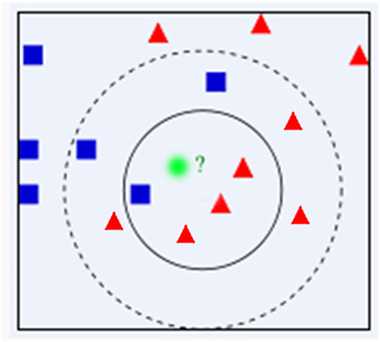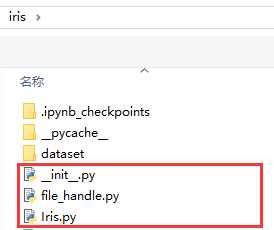基于K-Nearest Neighbors[K-NN]算法的鸢尾花分类问题解决方案(For Python)
2021-07-03 05:07
标签:view spec known UNC mat str 编程 测试 item 看了原理,总觉得需要用具体问题实现一下机器学习算法的模型,才算学习深刻。而写此博文的目的是,网上关于K-NN解决此问题的博文很多,但大都是调用Python高级库实现,尤其不利于初级学习者本人对模型的理解和工程实践能力的提升,也不利于Python初学者实现该模型。 本博文的特点: 一 全面性地总结K-NN模型的特征、用途 二 基于Python的内置模块,不调用任何第三方库实现 博文主要分为三部分: 基本模型(便于理清概念、回顾模型) 对待解决问题的重述 模型(算法)和评价(一来,以便了解模型特点,为以后举一反三地应用作铺垫;二来,有利于以后快速复习)、 编程实现(Code)。 特别声明: 1.劳动成果,未经同意博主(千千寰宇:http://cnblogs.com/johnnyzen),不得以任何形式转载、复制。 2.如有纰漏或者其他看法,欢迎共同探讨~ 零 基本模型 (本部分内容,均来源于引用[1],其原理讲解十分通俗易懂) ①K-近邻算法,即K-Nearest Neighbor algorithm,简称K-NN算法。单从名字来猜想,可以简单粗暴的认为是:K个最近的邻居,当K=1时,算法便成了最近邻算法,即寻找最近的那个邻居。 ②所谓K-NN算法,即是给定一个训练数据集,对新的输入实例,在训练数据集中找到与该实例最邻近的K个实例(也就是K个邻居), 这K个实例的多数属于某个类,就把该输入实例分类到这个类中。 ③实例 猜猜看:有一个未知形状(绿色圆点),如何判断其是什么形状? 问题:给这个绿色的圆分类? 对噪声数据过于敏感。为了解决这个问题,我们可以把位置样本周边的多个最近样本计算在内,扩大参与决策的样本量,以避免个别数据直接决定决策结果。 有两类不同的样本数据,分别用蓝色的小正方形和红色的小三角形表示,而图正中间的那个绿色的圆所标示的数据则是待分类的数据。 如果K=3,判定绿色的这个待分类点属于红色的三角形一类。 如果K=5,判定绿色的这个待分类点属于蓝色的正方形一类。 一 问题 题目:ML之k-NN:k-NN实现对150朵共三种花的实例的萼片长度、宽,花瓣长、宽数据统计,根据一朵新花的四个特征来预测其种类 二 解决过程及模型评价 由于前面第二部分已经详细叙述,且代码中注释已经十分详细,便不在对代码进行解释,阅读注释便容易懂。 __init__.py Iris.py file_handle.py 四 参考文献 [1] K-NN和K-Means算法:https://wenku.baidu.com/view/9544b6ea5a8102d276a22ffe.html 基于K-Nearest Neighbors[K-NN]算法的鸢尾花分类问题解决方案(For Python) 标签:view spec known UNC mat str 编程 测试 item 原文地址:https://www.cnblogs.com/johnnyzen/p/9625535.html
数据源:https://archive.ics.uci.edu/ml/machine-learning-databases/iris/iris.data
数据源说明:https://archive.ics.uci.edu/ml/machine-learning-databases/iris/iris.names


import random;
import math;
import Iris; # 自定义
import file_handle; # 自定义
#if __name__ == ‘__main__‘: #__name__ == ‘__main__‘是Python的main函数入口
def main(print_test=False,print_samples=False):
follows = []; # 样本集空间(前sampleAmount项)+测试集空间(后 sampleAll-sampleAmount项)
data = ""; # 样本数据(前sampleAmount项)+测试集空间(后 sampleAll-sampleAmount项)
sampleAll = 150;
sampleAmount = 100; # 标记样本集数目(剩余的便作为测试集)
k = 5;
test_print = print_test;
########## 一 读取数据集,装载样本集
##### 1.1 加载数据集数据
data = file_handle.read("./dataset/data.txt",1,‘r‘);#1:忽略第一行
# print(data);
list = data.split(‘\n‘);
i = 0;
for line in list: # 如:line = "5.1,3.5,1.4,0.2,Iris-setosa"
item = line.split(‘,‘);# 如:item = [5.1,3.5,1.4,0.2,Iris-setosa]
label_species = item.pop();#移除最后一项:标记种类
#print("[test] item:", item,"\tlabel_species:", label_species); # test
follows.append(Iris.Iris(item,label_species));
#print("[ ",i," ] ",follows[i].toString());
i += 1;
pass;
random.shuffle(follows); # 【千万注意!!!】由于原数据集是有序的,如果不做乱序处理,预测结果会及其不理想(准确率,趋近于0),当然,这也是这一模型的缺陷之一
##### 1.2 选择前100项 作为已标记样本集
#i = 0;
#for i in range(sampleAmount):
# follows[i].setPredictSpecies(follows[i].label_species);
# pass;
########## 二 训练测试样本
##### 2.1 对101 - 150 项的测试集进行训练/预测
## 算法描述:
## 遍历测试样本
## 计算测试样本与已标记的样本的欧式距离
## 对各欧式距离升序排序
## 选择前K项的已样本作为一子集( 即 选择最近的K项邻居作为参照标准)
## 遍历统计,已标记子集的花朵种类何种花朵数目种类最多
## 设置当前测试样本的预测花朵种类为该种
## 结束。
## 注释:花的种类分别为:Iris-setosa、Iris-versicolor、Iris-virginica;共计3种。
offset = 0; # 测试空间偏移量:目的是为了将通过偏移量,增大原已标记样本空间的样本数量 即 使已预测的测试样本加入参照样本空间。
for x in range(sampleAmount,sampleAll):# x:测试样本下标
weights = [];# 对各欧式距离(权值)的升序排序列表
for y in range(0,sampleAmount+offset):
result = (math.sqrt( + math.pow(follows[y].features[0] - follows[x].features[0],2) + math.pow(follows[y].features[1] - follows[x].features[1],2) + math.pow(follows[y].features[2] - follows[x].features[2],2) + math.pow(follows[y].features[3] - follows[x].features[3],2)), y);# 存储x,方便排序后定位花朵
#print("[test] weights[x]:", result);
weights.append(result);
pass;
weights.sort(key = lambda item:item[0]); # 以各元组内第一首项[欧氏距离]为键,默认升序排序
if test_print:
for m in range(len(weights)): # 输出预测权重
print("[test] weights[",m,"]:",weights[m],"\tweights[",m,"][1] > ",weights[m][1],":",follows[weights[m][1]].toString());
kinds_count = {"Iris-setosa":0,"Iris-versicolor":0,"Iris-virginica":0}; # 对已标记样本空间中各种花的数目统计作初始化
for z in range(0,k): # 选择前K项的已样本作为一子集( 即 选择最近的K项邻居作为参照标准)
if test_print:
print("[test] 排名前",z+1,"项 follows[",z,"]:",follows[weights[z][1]].toString());
label_species = follows[weights[z][1]].label_species;
if(label_species == ‘Iris-setosa‘):
kinds_count["Iris-setosa"] += 1;
elif label_species == ‘Iris-versicolor‘:
kinds_count["Iris-versicolor"] += 1;
elif label_species == ‘Iris-virginica‘:
kinds_count[‘Iris-virginica‘] += 1;
else:
print("[ERROR:Unknown Species] follows[",weight[z][1],"]:",follows[weight[z][1]]);
pass;
result = max(kinds_count.items(), key = lambda item:item[1]); # 取统计花类数字典中最大值对应的序列
follows[x].predict_species = result[0]; # 标记预测种类
if test_print:
print("[test] 预测结果",result, " [follows[",x,"].predict_species]:", follows[x].predict_species); # test
offset += 1;
#for test in range(len(weights)): # 测试-输出距离权值结果
# print("[",test,"] weights:",weights[test][0],"\t",follows[weights[test][1]].toString());
# pass;
pass;
########## 三 计算预测准确率
rate = 0.0;
i = 0;
for i in range(sampleAmount,len(follows)):
if(follows[i].label_species == follows[i].predict_species):
rate += 1;
else:
print("[预测错误样本] follow[",i,"]:",follows[i].toString());
pass;
pass;
rate = rate / (sampleAll - sampleAmount);
print("预测准确率:",rate);
if print_samples:
for i in range(0,len(follows)):
print(follows[i].toString());
pass;
pass;
main(False,True);
‘Iris module [class] ‘
__author__ = ‘Johnny Zen‘
class Iris:
"""
Iris花(类)
[Demo]
iris = Iris([5.1,3.5,1.4,0.2],"Iris-setosa");
print(iris.toString());
iris.setPredictSpecies(‘Iris-setosa‘);
print(iris.toString());
print(iris.label_species);
=======================
[features][5.1, 3.5, 1.4, 0.2] [label-species]Iris-setosa [predict-species]None
[features][5.1, 3.5, 1.4, 0.2] [label-species]Iris-setosa [predict-species]Iris-setosa
Iris-setosa
"""
features = [];
label_species = None; # 标记种类
predict_species = None; # 预测种类
def __init__(self,features,label_species=None):
if type(features).__name__ == ‘list‘:
self.features = features;
else:
self.features = list(features); # 此list方法对list对象执行将产生错误
pass;
for x in range(len(self.features)): # 列表内元素字符串转实数
self.features[x] = float(self.features[x]);
self.label_species = label_species;
pass;
def setPredictSpecies(self,predict_species=None):#设置预测种类
self.predict_species = predict_species;
pass;
def toString(self):#与一般函数定义不同,类方法必须包含参数 self[第一个参数]
return "[features]" + str(self.features) + "\t[label]" + str(self.label_species + "\t[predict]" + str(self.predict_species));
pass;
pass;
"file_handle module [function]:read(filepath,ignore=0,mode=‘r‘)"
def read(filepath,ignore=0,mode=‘r‘):
try:
file = open(filepath,mode);
## file_content = file.read();
file_content = ‘‘;
i = 0;
for i in range(0,ignore):
file.readline();
##print(i);
##print(file.readline());
for line in file.readlines():
file_content += line;
finally:
if file:
file.close();
#print(file_content);
return file_content;
pass;
文章标题:基于K-Nearest Neighbors[K-NN]算法的鸢尾花分类问题解决方案(For Python)
文章链接:http://soscw.com/essay/101123.html